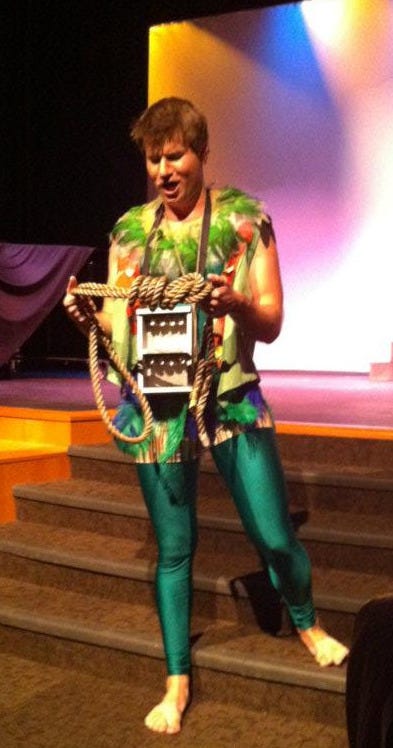I’ve been there…
The emotional posts.
The “real talk” captions.
The content so vulnerable and sincere it practically bled on the page.
I wasn’t trying to be clever.
I was trying to help.
Trying to wake people up.
Trying to make an industry see itself more clearly—because I knew it could be better.
And sometimes, it worked.
A chorus of thanks.
Dozens of shares.
Hearts. Claps. Validation. Applause.
But sales were rare.
And even more rare? Relief.
I learned the hard way that you can bring a horse to water—
but you can’t make it a client.
And when that horse is a highly trained professional, stuck in a fantasy that doesn’t match the current economy… it can sting even more.
The cruel irony of building a business around people you care about?
They’re often the ones most likely to stay exactly where they are.
Not because they’re lazy.
Not because they don’t believe in you.
But because you’ve built your platform on their resistance.
And you didn’t realize it until it was costing you everything.
That’s what no one tells you when you become the leader of the unready.
You show up every day thinking you’re building a movement.
But what you’re actually building…
is a very elegant trap.
You become:
A safe space
A soft place to land
A role model for holding pain well
But not necessarily a leader of people who want to change.
Your content hits hard—but still gets shared among people who love your voice, but won’t buy your work.
Your offers get applauded—but mostly by people who aren’t ready to receive what you’re really offering.
Your DMs fill with appreciation—but not the kind that leads to enrollment.
And the worst part?
It feels good.
It can feel like purpose. It can feel like momentum.
Until you realize…
You’ve built your business around the clients you most want to serve—but they don’t yet want to trust themselves to rise.

What Took Me Longer Than I Want to Admit
I spent years inside an industry where being “seen” was mistaken for being served.
Where people cried over posts, but never clicked through.
Where passion was high—but structural readiness was low.
I thought I had a messaging problem.
Or a platform problem.
Or a pricing problem.
But what I had was more like a proximity problem.
I was too close to the community I was trying to save.
So I made the most important decision of my entire business life:
I decided to starve the starving artist within once and for all.
Because if I didn’t, no one would believe me when I said there was another way.
The truth is: my business didn’t fail.
In fact, it succeeded in one of the hardest ways possible—offering a service people needed, in a community that mostly didn’t want it.
I made money anyway.
I built a following.
I found extraordinary clients who did rise.
But I’ll admit I also exhausted myself trying to make the unready ready.
It’s not easy to make transformation feel “safe” to those you’re not meant to serve.
I diluted clarity in the name of care.
But that business didn’t break me.
It prepared me.
It gave me the strength, the discernment, and the standards to know exactly what my business would evolve into next.
What most people don’t realize about shifting your niche…
You don’t always need to change your audience.
But you may need to change the reason they come to you.
There’s nothing wrong with serving a specific group—Artists, educators, therapists, voice teachers… they all deserve thoughtful, mission-aligned support.
But if your business is struggling to grow, it’s worth asking:
Are you being hired—or expected to work for free—because of who you serve?
Or are you being hired because of the specific problem you solve?
That’s what changed everything for me.
When I first launched , my work was framed around helping artists and creatives thrive.
But that problem was too identity-bound—and not always clear enough to trigger investment.
People nodded. They clapped. They agreed.
But only a handful paid.
Others gave me pity.
The shift came when I got radically clearer on the actual problems I was solving:
Over-delivery as a self-worth strategy
Confusion between care and compensation
Voices being used to serve others, but never to price and earn with power
And that’s how was born.
Not as a rebrand for fun—but as a structural decision to stop selling help…
and start solving the specific business problems high-functioning, underpaid people across industries already know they have.
So I don’t just work with artists.
I work with entrepreneurs, educators, executive leaders, and service-based professionals who are done explaining their value and are ready to earn in alignment with it.
That’s the difference between an identity-based niche and a problem-defined business.
You don’t have to abandon your audience.
You just have to build your business around what actually moves them.

When the System Trains You to Stay Stuck
Reading The Death of the Artist by William Deresiewicz confirmed what I already knew:
Most artists are trained for a professional world that, for too many, no longer exists. The book should be required reading in college—but we know it won’t be!
Because the narrative has yet to change.
Increasing numbers of students are still being encouraged to pursue artistic careers—often with the belief that struggle is noble, and that financial success would somehow compromise the art.
The reality? These are broken systems. And lasting traditional real-world income can be harder than ever to come by.
Some schools are evolving—and some faculty are truly doing their best. But the following is still true for far too many:
We train artists in scarcity.
We teach them to hope for discovery—rather than build anything sustainable.
We call it education.
But too often, it’s just a slow detour into disillusionment.
For too many, reality doesn’t hit until long after graduation—sometimes not even until they’ve earned a graduate degree.
And many freeze.
They stay in “student mode” long after the diplomas are framed—
still waiting for someone else to set the rules, assign the path, or give them permission to begin.
It’s painful to watch.
Professors aren’t supposed to be life coaches after graduation.
But no one gives these students an off-ramp—
and I once dreamed of being it.
To give them what college couldn’t.
To make the careers they wanted actually viable.
But most resisted the very business infrastructure that could make it more possible.
They didn’t want help.
They wanted more school—but without the structure, without the tuition, and without the follow-through.
It’s like the career equivalent to when Papageno in The Magic Flute, moments before the bells save him, cries out,“No one loves poor Papageno… I’ll hang myself by this tree.” Desperate—yet still holding what could save him.
You can’t free someone who already holds the tool for their liberation, but still clings to the comfort of the familiar.

Learning Not to Take Things Personally
(Even When You’re Holding the Bells)
One of the books I wish I had been forced to read in college is The Four Agreements by Don Miguel Ruiz.
As an entrepreneur, I’ve come back to it often—especially when no one shows up, the silence is loud, and the resistance feels personal.
Be impeccable with your word.
Don’t take anything personally.
Don’t make assumptions.
Always do your best.
Because in this work, some people will praise you, quote you, even thank you—
but still won’t move.
And that’s not your failure.
It’s the structure they’ve chosen to stay inside.
I stopped building for the part of me that stayed stuck—
and started building for the version that finally chose to rise.
Because you can’t convert someone still clinging to their coping mechanisms.
You can’t coach someone out of a structure they’re emotionally attached to.
And you can’t run a business where your client’s loyalty to struggle is stronger than their desire for sovereignty.
This clarity didn’t arrive in a single moment—it formed over hundreds of small ones. Notes I never published. Half-written drafts. Things I didn’t feel ready to say until now.
So What Did I Do?
I stopped centering the unready.
I stopped being available to people who needed me to prove I wasn’t “abandoning them.”
I stopped making content that comforted everyone…
and started building infrastructure for people who were ready to move.
That doesn’t mean I became cold—it means I stopped leaking warmth into people who weren’t going to do anything with it.
The business I have now?
It doesn’t depend on applause.
It doesn’t require me to “get back to posting.”
It’s built on structural clarity.
Buyer readiness.
And a standard that says:
You don’t need to need me. You just need to be ready.
That’s the real difference.
If you’re reading this and it stings…
You might still be building for the unready.
You might be mistaking emotional engagement for economic alignment.
You might be stuck in an ecosystem where people look up to you—but never rise.
That’s not your failure.
That’s the design.
You don’t need to burn it all down.
You don’t need to leave your industry or change your values or rebrand your heart.
But you do need to stop proving your care through over-delivery.
And start honoring your clarity with structure.
You’ve earned the right to build for readiness.
You’ve earned the right to serve the future.
And you’ve earned the right to finally be paid…
not for being relatable, but for being right on time.
Thanks for reading.
—Brian
PS - If you're building for readiness—and want help doing it right the first time—I'm here. Just send me a message. Quiet clarity. Real structure. No applause required.







You did a brilliant job of truly breaking down the differences between those you want to serve and ensuring that you have a specific problem that will move the needle with them and turn them into paying clients